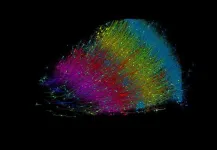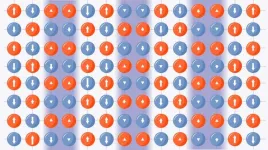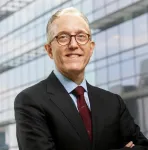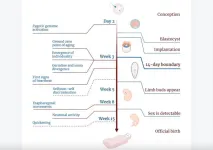(Press-News.org) As the world is transitioning from a fossil fuel-based energy economy, many are betting on hydrogen to become the dominant energy currency. But producing “green” hydrogen without using fossil fuels is not yet possible on the scale we need because it requires iridium, a metal that is extremely rare. In a study published May 10 in Science, researchers led by Ryuhei Nakamura at the RIKEN Center for Sustainable Resource Science (CSRS) in Japan report a new method that reduces the amount of iridium needed for the reaction by 95%, without altering the rate of hydrogen production. This breakthrough could revolutionize our ability to produce ecologically friendly hydrogen and help usher in a carbon-neutral hydrogen economy.
With 70% of the world covered in water, hydrogen is truly a renewable source of energy. However, extracting hydrogen from water on a scale that can rival fossil fuel-based energy production is not yet possible. Current global energy production is almost 18 terawatts, meaning that at any given moment, about 18 trillion watts of power is being produced on average worldwide. For alternative green methods of energy production to replace fossil fuels, they must be able to reach the same rates of energy production.
The green way to extract hydrogen from water is an electrochemical reaction that requires a catalyst. The best catalysts for this reaction—the ones that yield the highest rate and the most stable hydrogen production—are rare metals, with iridium being the best of the best. But the scarcity of iridium is a big problem. “Iridium is so rare that that scaling up global hydrogen production to the terawatt scale is estimated to require 40 years’ worth of iridium,” says co-first author Shuang Kong.
The Biofunctional Catalyst Research Team at RIKEN CSRS is trying to get around the iridium bottleneck and find other ways of producing hydrogen at high rates for long periods of time. In the long run, they hope to develop new catalysts based on common earth metals, which will be highly sustainable. In fact, the team recently succeeded in stabilizing green hydrogen production at a relatively high level using a form of manganese oxide as a catalyst. However, achieving industrial level production in this manner is still years away.
“We need a way to bridge the gap between rare metal- and common metal-based electrolyzers, so that we can make a gradual transition over many years to completely sustainable green hydrogen,” says Nakamura. The current study does just that by combining manganese with iridium. The researchers found that when they spread out individual iridium atoms on a piece of manganese oxide so that they didn’t touch or clump with each other, hydrogen production in a proton exchange membrane (PEM) electrolyzer was sustained at the same rate as when using iridium alone, but with 95% less iridium.
With the new catalyst, continuous hydrogen production was possible for over 3000 hours (about 4 months) at 82% efficiency without degradation. “The unexpected interaction between manganese oxide and iridium was key to our success,” says co-author Ailong Li. “This is because the iridium resulting from this interaction was in the rare and highly active +6 oxidation state.”
Nakamura believes that the level of hydrogen production achieved with the new catalyst has high potential for immediate usefulness. “We expect our catalyst to be easily transferred to real-world applications,” he says, “which will immediately increase the capacity of current PEM electrolyzers.”
The team has begun collaborating with partners in industry, who have already been able to improve on the initial iridium-manganese catalyst. Moving forward, the RIKEN CSRS researchers plan to continue investigating the specific chemical interaction between iridium and manganese oxide, with hopes of reducing the amount of necessary iridium even more. At the same time, they will continue collaborating with industrial partners, and plan on deploying and testing the new catalyst on an industrial scale in the near future.
END
Manganese sprinkled with iridium: a quantum leap in green hydrogen production
2024-05-09
ELSE PRESS RELEASES FROM THIS DATE:
Topological Phonos: Where vibrations find their twist
2024-05-09
An international team of researchers has discovered that the quantum particles responsible for the vibrations of materials—which influence their stability and various other properties—can be classified through topology. Phonons, the collective vibrational modes of atoms within a crystal lattice, generate disturbances that propagate like waves through neighboring atoms. These phonons are vital for many properties of solid-state systems, including thermal and electrical conductivity, neutron scattering, and quantum phases like charge density waves and superconductivity.
The spectrum of phonons—essentially ...
A fragment of human brain, mapped
2024-05-09
A cubic millimeter of brain tissue may not sound like much. But considering that tiny square contains 57,000 cells, 230 millimeters of blood vessels, and 150 million synapses, all amounting to 1,400 terabytes of data, Harvard and Google researchers have just accomplished something enormous.
A Harvard team led by Jeff Lichtman, the Jeremy R. Knowles Professor of Molecular and Cellular Biology and newly appointed dean of science, has co-created with Google researchers the largest synaptic-resolution, 3D reconstruction of a piece of human brain to date, showing in vivid detail each cell and its web of neural connections in a piece of human ...
Quantum breakthrough sheds light on perplexing high-temperature superconductors
2024-05-09
Superfast levitating trains, long-range lossless power transmission, faster MRI machines — all these fantastical technological advances could be in our grasp if we could just make a material that transmits electricity without resistance — or ‘superconducts’ — at around room temperature.
In a paper published in the May 10 issue of Science, researchers report a breakthrough in our understanding of the origins of superconductivity at relatively high (though still frigid) temperatures. The findings concern a class of superconductors that has puzzled scientists since 1986, called ‘cuprates.’
“There was tremendous excitement when ...
Vilcek Foundation appoints Dr. Jedd Wolchok to Board of Directors
2024-05-09
The Vilcek Foundation has announced the appointment of Dr. Jedd Wolchok to the board of directors, effective May 1, 2024. Wolchok is the Meyer Director of the Sandra and Edward Meyer Cancer Center and a professor of medicine at Weill Cornell Medicine in New York.
“Jan, Marica, and I are delighted to welcome Jedd to the Vilcek Foundation board,” says Vilcek Foundation President Rick Kinsel. “We look to our board of directors for insight and perspective on our projects and programs: Jedd is not only a leader in immunotherapy and oncology, but an academic and scientific mentor, and a philanthropist in his own right. We are honored and grateful to have him ...
Local health equity and social impact entrepreneurs invited to apply for grants, training
2024-05-09
DALLAS, May 09, 2024 — A recent study revealed that, in the United States, local Black and Latino entrepreneurs receive just 2.6% of all venture capital investment.[1] To help bridge that gap and while addressing health inequities in these local communities, the American Heart Association, celebrating 100 years of lifesaving service, is offering financial grants and expert business consulting to local social health impact entrepreneurs who are focused on achieving health equity. As the Association commemorates one hundred years of lifesaving service as the world’s leading nonprofit ...
The beginning of becoming a human
2024-05-09
“Debates on when human life begins are rooted deep in philosophical history. However, until recently they have been limited by the state of technology.”
BUFFALO, NY- May 9, 2024 – A new review paper was published in advance by Aging (listed by MEDLINE/PubMed as "Aging (Albany NY)" and "Aging-US" by Web of Science), entitled, “The beginning of becoming a human.”
According to birth certificates, the life of a child begins once their body comes out of the mother’s womb. In this new review, researchers Polina A. Loseva and Vadim N. Gladyshev from Harvard Medical School pose ...
Veterinary educator receives national award
2024-05-09
The American Association of Veterinary Medical Colleges has named India Lane the winner of the 2024 Billy E. Hooper Award for Distinguished Service. Lane, associate dean for academic and student affairs at the University of Tennessee College of Veterinary Medicine (UTCVM), has helped transform academic veterinary medical education not only at the college but throughout the profession. The national award recognizes an individual whose leadership and vision have made a significant contribution to academic veterinary medicine.
Throughout ...
Deep learning-based whole-body PSMA PET/CT attenuation correction utilizing Pix-2-Pix GAN
2024-05-09
“We have developed a Pix-2-Pix GAN model to perform attenuation correction on whole-body PSMA [prostate-specific membrane antigen] PET images with 18F-DCFPyL.”
BUFFALO, NY- May 9, 2024 – A new research paper was published in Oncotarget's Volume 15 on May 7, 2024, entitled, “Deep learning-based whole-body PSMA PET/CT attenuation correction utilizing Pix-2-Pix GAN.”
The sequential PET/CT studies oncology patients can undergo during their treatment follow-up course is limited ...
Association between neighborhood deprivation and DNA methylation in an autopsy cohort
2024-05-09
“[...] our study identified one CpG site (cg26514961, PLXNC1 gene) that was significantly associated with neighborhood deprivation in brain tissue.”
BUFFALO, NY- May 9, 2024 – A new research paper was published in Aging (listed by MEDLINE/PubMed as "Aging (Albany NY)" and "Aging-US" by Web of Science) Volume 16, Issue 8, entitled, “The association between neighborhood deprivation and DNA methylation in an autopsy cohort.”
Previous research has found that living in a disadvantaged neighborhood is associated with poor health outcomes. Living in disadvantaged neighborhoods may alter inflammation and immune response in the ...
A better way to control shape-shifting soft robots
2024-05-09
Imagine a slime-like robot that can seamlessly change its shape to squeeze through narrow spaces, which could be deployed inside the human body to remove an unwanted item.
While such a robot does not yet exist outside a laboratory, researchers are working to develop reconfigurable soft robots for applications in health care, wearable devices, and industrial systems.
But how can one control a squishy robot that doesn’t have joints, limbs, or fingers that can be manipulated, and instead can drastically alter its entire shape at will? MIT researchers are working to answer that question.
They developed a control algorithm that can autonomously learn ...








